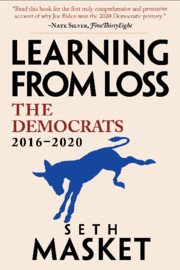Book contents
- Learning from Loss
- Learning from Loss
- Copyright page
- Dedication
- Contents
- Figures
- Tables
- Acknowledgments
- Chapter 1 When the Fools Were Right
- Chapter 2 What We Know About Identity, Ideology, and Electability, and What We Don’t
- Chapter 3 Interpreting Loss
- Chapter 4 When Parties Try to Fix Themselves
- Chapter 5 The Persistence of Faction
- Chapter 6 How Narratives Change Voters
- Chapter 7 The Invisible Primary Becomes Visible
- Index
Chapter 1 - When the Fools Were Right
Published online by Cambridge University Press: 11 September 2020
- Learning from Loss
- Learning from Loss
- Copyright page
- Dedication
- Contents
- Figures
- Tables
- Acknowledgments
- Chapter 1 When the Fools Were Right
- Chapter 2 What We Know About Identity, Ideology, and Electability, and What We Don’t
- Chapter 3 Interpreting Loss
- Chapter 4 When Parties Try to Fix Themselves
- Chapter 5 The Persistence of Faction
- Chapter 6 How Narratives Change Voters
- Chapter 7 The Invisible Primary Becomes Visible
- Index
Summary
This was supposed to be a book about Republicans. In the summer of 2016, I had an idea for a book chronicling how the Republican Party dealt with their embarrassing loss to Hillary Clinton. Surely they were going to have to rethink how their presidential nomination system worked, why it utterly failed in 2016, and how a patently unelectable candidate like Donald Trump somehow got the nomination and cost them an election that was obviously theirs to win. It would be a difficult period of self-reflection for the GOP (Grand Old Party), and it seemed like something that would be fascinating to observe in action.
Information
- Type
- Chapter
- Information
- Learning from LossThe Democrats, 2016–2020, pp. 1 - 16Publisher: Cambridge University PressPrint publication year: 2020
